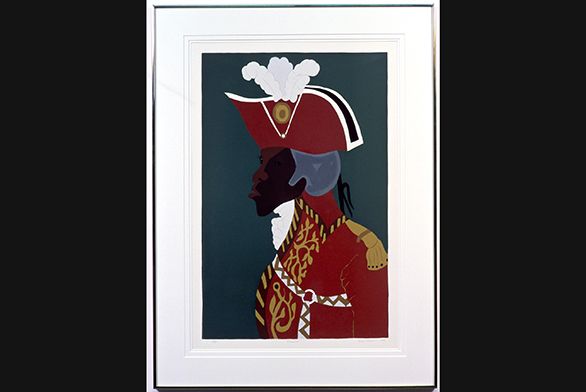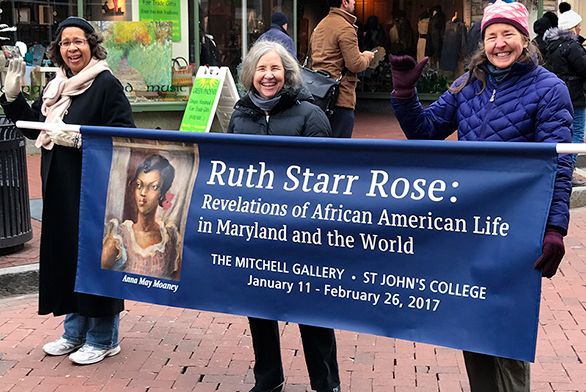Mitchell Gallery Kicks Off Online Year with Jacob Lawrence Exhibition
September 14, 2020 | By Les Poling

Every year, the Mitchell Gallery—the only accredited college art museum in Maryland—brings a full year of programming to Mellon Hall, with exhibitions ranging from “Works by Warhol from the Cochran Collection” to “Ruth Starr Rose: Revelations of African American Life in Maryland and the World.” On the one hand, such collections showcase the brilliance of an artist, group, or movement. On the other, they represent the efforts of the Mitchell Gallery staff: the years of careful planning, logistical wrangling, and curatorial work that happens behind the scenes.
That’s part of what makes this fall’s Mitchell Gallery programming so remarkable. Like every other exhibition, “Jacob Lawrence: Three Series of Prints: Genesis | Toussaint L’Ouverture | Hiroshima” has been in the works for years. However, it’d be hard to find a timelier showing. Lawrence, widely considered one of the most important artists of the 20th century, is “renowned for his modernist depictions of everyday life as well as epic narratives of African American history and historical figures” (DC Moore Gallery). The everyday, the epic, the extraordinary, and the historical are all represented in “Three Series of Prints”—and those adjectives could easily describe America’s summer of protest, pandemic, and self-examination. “[The timing is] good happenstance,” says Mitchell Gallery Art Educator Lucinda Edinberg.
Unfortunately, despite its relevance, there will be no students, no study groups, and no community members to see Lawrence’s work in person. Due to COVID-19 and renovations to Mellon Hall, the Mitchell Gallery has moved online for the entire 2020-21 season.
The Mitchell Gallery first transitioned to virtual programming in mid-March, when the coronavirus pandemic forced St. John’s to close. Originally, with the Annapolis campus planning to reopen after two weeks, neither Edinberg nor recently retired Mitchell Gallery Director Hydee Schaller planned to create any virtual content. That quickly changed when campus closed for the semester. The Mitchell Gallery’s last exhibition of the 2019–20 academic year, “American Indian Art from the Fenimore Art Museum: The Thaw Collection,” was open for only six days before St. John’s moved online. Almost out of desperation, Edinberg and Schaller conceived of web content to keep the gallery “open” to visitors.
“We started out with a virtual gallery tour,” Edinberg recalls. With the help of a friend, Steve Burns—a videographer who’d worked for National Geographic, the Discovery Channel, and more—Edinberg filmed several showcases of the Thaw Collection for the Mitchell Gallery Facebook page. “Those were spontaneous, two-minute videos, and they’re a little rough, but people watched them,” she says. Inspired by the warm reception, Edinberg took detailed photos and videos of individual objects in the exhibition and created PowerPoint presentations with in-depth analysis and exploration, replicating the experience of teaching in the gallery. “It was a way to keep the exhibition alive,” she explains.
But one semester of virtual offerings is vastly different than one year. News that the Mitchell Gallery would be closed for 2020-21 arrived at

the end of May, along with the announcement that Schaller would retire at the end of August. After several weeks of back and forth, the gallery decided to move online. “And then I really started working full force,” says Edinberg. “I wanted to make it something that’s not just staring passively at a computer screen.” With the goal of compiling more interactive programming, Edinberg and the Mitchell Gallery put together a full roster of remote events, including lectures, book club discussions, a virtual concert and Q & A session with George Winston, a moderated interview with Alitash Kebede, an online family event, and much more.
The season officially started on September 2 with prints from Lawrence’s “Genesis:” a series of stark, eye-catching works depicting a messiah-like preacher delivering a sermon alongside passages from the Book of Genesis. While inspired by the text, Lawrence’s childhood bears enormous influence on these prints, particularly the Sundays he spent at the Abyssinian Baptist Church in Harlem. For more than 200 years, Edinberg explains, Abyssinian served as a place of worship, social life, and political gathering, and the charismatic leaders of the church—Adam Clayton Powell and his son, Adam Clayton Powell, Jr.—participated actively in spiritual ministry and community organizing. Fittingly, Lawrence’s interpretation of the Book of Genesis is not merely an artist’s visualization of the written word, but a portrayal of the human experience of the divine: a preacher telling the Biblical creation story. “Genesis,” in Lawrence’s hands, is the word in action.
Similarly, the second and third series of prints bring still-resonant vibrancy to written works. “Toussaint L’Ouverture” (opening October 7), inspired by C.R.L. James’ seminal book on the Haitian Revolution, The Black Jacobins, shows bold, bright images of various battles and the eponymous revolutionary general who led Haiti’s overthrow of French colonization and its liberation from slavery—which, according to the Brown University Library, “culminated in the first independent nation in the Caribbean, the second democracy in the western hemisphere, and the first Black republic in the world.” Edinberg believes it’s easy to see the connection between Lawrence’s work and the news playing out on American TV screens, as protestors call for a reckoning with the enduring history of slavery in the United States.
“Those images are so powerful because this was the largest revolution and rebellion against slavery in Haiti’s history,” she says. “It is a similar scenario to what we’re going through now, as a society, and I think that’s part of the reason [“Toussaint L’Ouverture”] feels so pertinent.”
No less relevant, the prints from the “Hiroshima” series (opening November 18) coincide with this year’s 75th anniversary of the Hiroshima and Nagasaki bombings. Based on John Hersey’s “Hiroshima,” which itself consisted of interviews with six survivors of the atomic bomb dropped by the United States, the “Hiroshima” prints showcase scenes of everyday life in the Japanese city. Despite the vivid colors and almost mundane normalcy of the subject matter, there is an unbearable sense of menace looming over the works, as if we are witnessing the blissful last moments before the mushroom cloud. In contrast to the “Toussaint L’Ouverture” series, which conveys movement, suspense, and revolution, “Hiroshima” feels like the quiet before an apocalyptic storm.
“‘Hiroshima’ is much more broken up [than ‘Toussaint L’Ouverture,’]” Edinberg says. “The faces are much more abstract, they’re not distinct, and you get a sense of that unspeakable horror while people are trying to go about their everyday lives.”
“It bothers me to look at the ‘Hiroshima’ prints,” she adds. “And that discomfort is part of the experience.”
The visceral impact of the Jacob Lawrence exhibition underscores the disappointing fact that the works can’t be experienced in the gallery. Nonetheless, Edinberg hopes the interactive virtual programming will engage “visitors” in a serious meditation of the work at hand, and she believes that even on a screen, the prints have the power to expand the perspectives of anyone who engages seriously with Lawrence’s mastery. “They’re purposeful, they’re focused, they’re well-crafted, they’re artistic, and they speak to everyone,” she says. “Lawrence conveys this message and this need for change in a way that’s intentional but not antagonistic.”
And it’s not just this exhibition, she stresses, that has the ability to broaden perceptions. Since 1989, Edinberg says the Mitchell Gallery’s diverse programming has both complemented and diverged from the Program, enriching the St. John’s experience for students and community members alike.
“The mission is to tell other stories,” she declares. “It’s to give gallery visitors a wide worldview. And that’s what makes my job so interesting.”

